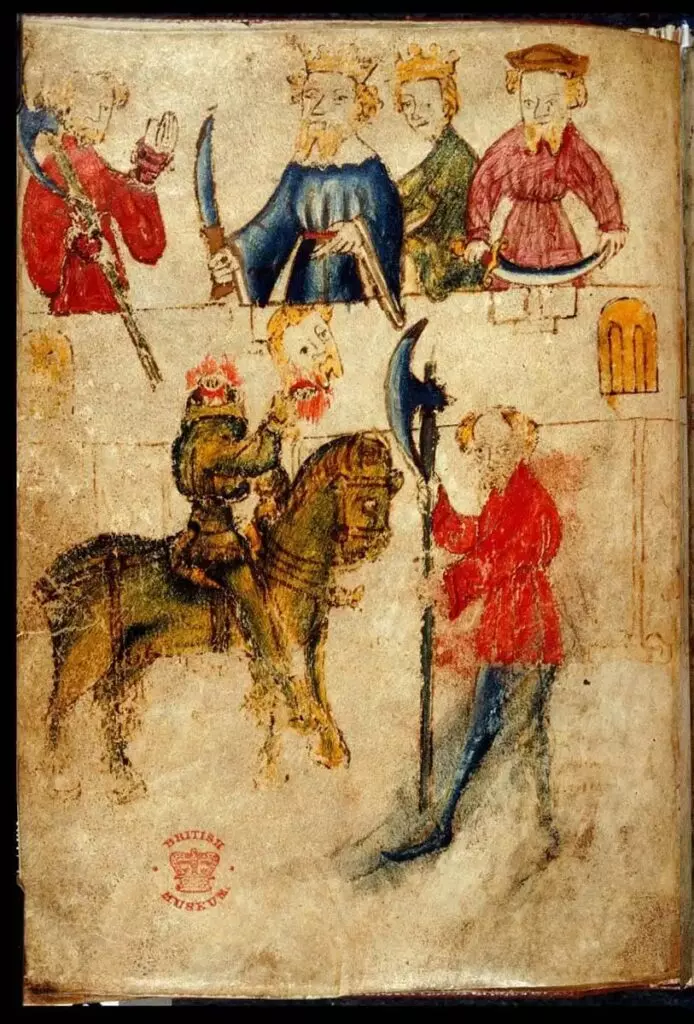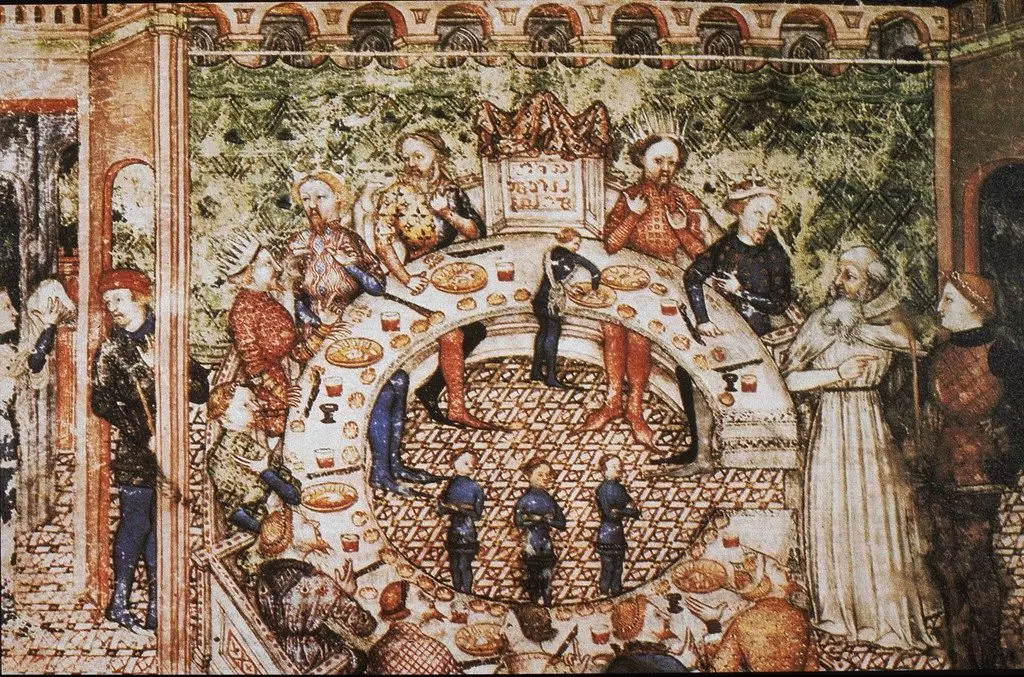Sir Gawain and the Green Knight is thoroughly a Christmas story. The anonymous author sets the scene in a festive “Camelot at Christmastide” (Borroff 2010, line 37). Indeed, much of the poem is dominated by the Christmas setting, accentuated by the year that speeds by between promised blows of Gawain and the Green Knight. A mysterious Green Knight then punctures this familiar setting, becoming a symbol of Christmas motifs and an agent of rebirth throughout the poem. The Green Knight’s Christmas setting comes with all the motifs expected of a Christmas story. The colors of the season repeat allegorically, bringing different meanings; a proverbial light constantly shines through the darkness of the poem, and rebirth occurs to bring about the New Year. Using the colors of the season of Christmas, the poem addresses questions regarding how to live a good life, celebrates death, and embraces rebirth. Sir Gawain and the Green Knight’s action is shaped to fit the motifs of Christmas, thereby acting as a Christmas poem, and teaching a message of spiritual rebirth in the guise of a chivalric romance.
Traditional Christmas colors—not only green—act as significant symbols throughout the poem, and Gawain and the Green Knight brim with Christmas’s colors. The Green Knight enters Camelot, proposing his game, all the while “In his hand, he had a holly bob,” which the narrator reminds “is goodliest in green when groves are bare” (205-06). Amongst the Knight’s overwhelming greenery—an enduring symbol of Christmas—other symbolic colors are sprinkled in. The Green Knight’s “gold spurs” and “red eyes” gleam distinctly as the remaining two colors associated with Christmas (159, 305). Gawain, too, standing in his armor, shines “all red, / With the pentangle portrayed in purest gold” exudes Christmas spirit (619-20). His girdle “of a gay green silk, with gold overwrought,” gifted to him by the Lady, completes the missing symbolic color (1832). Both Gawain and the Green Knight, by the end of the poem, physically possess all three colors, in differing proportions. Each color—red, green, and gold—represents a different value in life, and the proportion of color each character possesses indicates their dedication to that virtue. These three values, generally described as liveliness, flexibility, and purity are commonly preached motifs around Christmas.
The Green Knight and Gawain represent the two predominant colors of Christmas—the Knight, green, and Gawain, red. While both red and green epitomize Christmas, within the greater context of the season they represent different aspects of life and rebirth within the poem. Gawain’s redness, the color of blood, represents life and the vitality of Camelot’s chivalry. Given the emphasis of the Christmas season, red inevitably becomes reminiscent of the blood of Christ, invoking imagery of the blood he asks his disciples to drink, and which he shed on the cross to forgive humanity for their sins. The spirituality surrounding red is further emphasized by Gawain’s red shield, upon the outside of which is painted a golden pentangle, an “endless knot,” to remind all of “the five wounds / That Christ got on the cross” (642-43). While on the inside of his shield, “he fittingly had” the Virgin Mary’s “image portrayed” (648-49). Gawain’s redness is a spiritual celebration of Christmas and Christ.
The Green Knight’s hue celebrates and challenges the same Christmas motif of birth in a natural way. The Green Knight’s accompaniments, the ax, and the Green Chapel, relate to nature and its taming, as well as to life and death. The Green Chapel is not a church but a barrow with “a hole at one end, and on either side, / … covered with coarse grass in clumps all without, / And hollow all within” (2180-83). The Green Chapel functions similarly to Gawain’s shield. Both celebrate life by honoring death. The barrow does this by establishing the mound, atop a final resting spot, as a symbolic memory of life. Gawain’s shield has the same purpose; it remembers the life of Christ symbolically through his death and five wounds. The Knight’s ax conversely represents the ending of life, either through the felling of trees or the lopping off of heads.

The Green Knight’s color goes further than connecting him to nature. His greenness also serves as a physical manifestation of wildness. Throughout the poem, he acts outspokenly, and with unchivalrous manners. These two qualities are wholly unique to the Green Knight, as Gawain and Lord Bertilak display none of those tendencies. His entrance is as wild and untamed as it is uncourteous. He punctuates the jovial Christmas setting by “riding to the high dais,” simply demanding “‘where is … the captain of this crowd?’” (222-25). The wildness at the heart of the Green Knight’s actions and appearance mimic nature and the untamed land that surrounds Camelot. Like the natural world, the Knight presents a challenge with clear rules. His challenge, that Gawain’s “neck should have a knock,” in one year follows the flowing of time and the seasons (453). Through emphasizing the game’s temporality, the Green Knight presents a direct path to death. This timeframe further emphasizes the important symbolic nature of Christmas and the New Year, hinting that through the deathly appearance of his game one may be reborn, like Christ, or the Earth into a New Year. To meet this challenge chivalrously, Gawain must ride out into the “country wild,” braving nature at the same time he must brave the Green Knight (713).
The Green Knight’s wild and naturally unpredictable nature acts to create darkness for Gawain. The function of Gawain’s quest is to brave and pierce the darkness around him and return to Camelot alive. His meeting with Lord Bertilak serves as that light in the darkness for Gawain. Lord Bertilak appears biblically, a Christmas miracle, the answer to Gawain’s prayers to Mary for “harborage where haply I might hear mass” (755). Lord Bertilak’s religious connotations continue past his holy advent. He appears almost like a living God among men “so comely a mortal never Christ made,” “arrayed royally in radiant hues” (871, 868). Where Gawain and the Knight are red and green, Lord Bertilak is bright and golden. His castle is richly ornamented with “silk hangings hemmed all in gold,” and “curtains…caught to gold rings” (854, 857). With his appearance, all the Christmas colors are represented by a character in the poem.
Lord Bertilak’s golden hue is a middle ground between the Knight’s wild Green and Gawain’s chivalric red. Bertilak possesses the natural aspect of the Green Knight while retaining the courtly aspect of Gawain. Throughout the poem, Lord Bertilak is closely associated with nature. His face is “fair and fresh as the flowers of spring,” yet also “fierce as fire” (866, 847). Unlike the Green Knight who is simply Green, Lord Bertilak is dichotomic—thoroughly natural, consisting of both the pleasant and the dangerous. Every day he hunts, killing various animals, but always gifts his spoils. In this way, the dichotomy of his character continues. He is natural but chivalrous—a trait wholly lacking in the Green Knight. His introduction to Gawain contains the courtliness the Green Knight, and even King Arthur, lacked. As Lord Bertilak goes down to greet Gawain in the hall he declares,
“‘To this house you are heartily welcome:
What is here is wholly yours, to have in your power and sway.’ ‘Many thanks,’ said Sir Gawain;
‘May Christ your pains repay!’” (835-39)
Lord Bertilak represents the perfect character in the poem. His naturalness implies a flexibility that Gawain lacks— Gawain’s ridged pentangular code of honor cannot fit into all situations. Bertilak’s courtesy is the purest in the poem. He is not afraid like King Arthur and is completely open and welcoming. Lord Bertilak’s courtesy also exceeds Gawain’s, who, by accepting the green girdle and neglecting to tell Lord Bertilak, exploits the Lord’s courtesy.
When Gawain accepts the green girdle from Lady Bertilak he accepts some of the wild, natural, and flexible into his life. But he only accepts this out of fear. Initially, when the girdle is just a belt, it is easy for Gawain to decline “so simple a thing” (1847). However, once he learns that while wearing the belt “there is no hand under heaven that could hew him down,” he feels forced to accept it (1853). By accepting the girdle, his first green token, and the last of the three Christmas colors he possesses, he is saving his life. The girdle’s green acts as a forced amendment to the red and gold pentangle by which Gawain lives. It teaches him a bitter lesson which he “must bear…on [his] body till [he] breathes [his] last” (2510). Gawain, at the start of the poem, was only red and gold. The redness of his armor symbolized his vitality and life, and the gold denoted the goodness of his character. Lord Bertilak and the Green Knight are overwhelmingly green and gold. The Green Knight form expresses the need for a life punctuated by the flexibility required of nature. Lord Bertilak’s human, Lordly form, denotes an inner purity of soul, which he has in common with Gawain. Through their encounter, Gawain is forcibly taught the importance of having green—flexibility and nature—in life. At Lord Bertilak’s hand, on New Year’s Day, Gawain is reborn, remade into a new man with an amended moral compass. He chooses to forever wear the green girdle as a reminder of his previous, flawed self, “for where a fault is made fast, it is fixed evermore” (2512). Gawain pledges to live his life in the manner of all three colors: first, with red or vigor and fealty to God; then, with gold or inner purity according to the five knightly virtues; and now, finally, with green, the flexibility required by nature.
Bibliography
Borroff, Marie, translator. 2010. Sir Gawain and the Green Knight. Edited by Marie Borroff, and Laura L. Howes. First Edition. New York: W. W. Norton & Company.

Leave a Reply